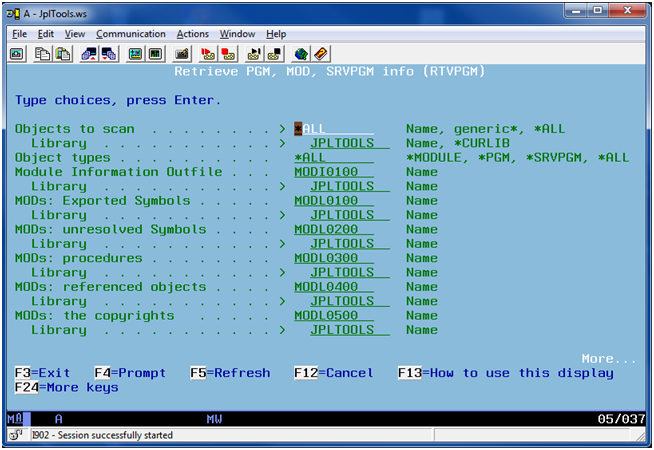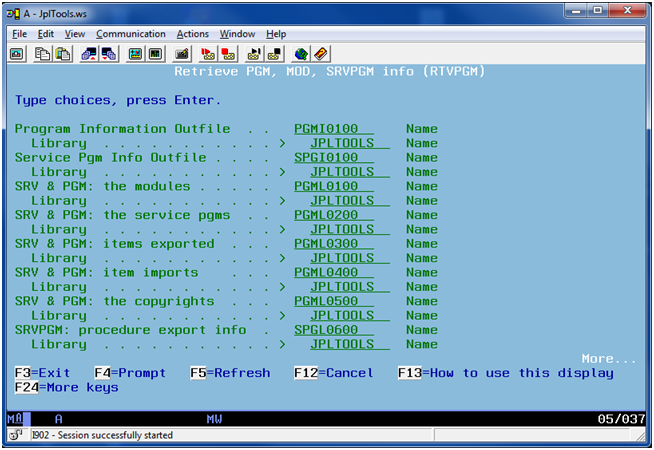
Tips & Techniques - System Administration
Written by Jean-Paul Lamontre
Friday, 10 August 2012 00:00
Fill the gap between modules and ILE programs for a full panorama of your ILE application.
Part I and Part II of this series have shown how some system commands can be used to dissect in depth one application, without the source code. But these analyses suffer from a lack of information for ILE programs-namely, the link between the program and embedded modules.
Indeed, for OPM programs, the command DSPOBJD provides a direct link between the program and source code. This is possible because the compiler goes directly from the source code to the program without going through an object module. Conversely, for ILE programs, DSPOBJD does not give such information. It cannot: ILE programs can be composed of several modules.
Although each module knows the name of its source code (and DSPOBJD knows how to find that), the link between a program and the list of modules is inaccessible: the command DSPPGM does not offer OUTPUT(*FILE).
This third article shows first the command RTVPGM, based on the six APIs shown below. This command and these APIs provide an OUTPUT(*FILE) equivalent to the output screens of DSPMOD, DSPPGM, and DSPSRVPGM. These OUTFILE outputs are a one-to-one relationship for most of the formats of these APIs.
This article then shows the scripts used to extract information from these files.
The command RTVPGM explores objects of type * MODULE, * PGM, and * SRVPGM. It produces 16 files:
Three describe the basic information modules, programs, and service programs:
Five to describe the attachment of modules:
Five describe programs and service programs' attachments:
Three describe specific service programs' attachments:
Figures 1 through 3 show the three screens of the RTVPGM command

Figure 1: In RTVPGM page 1, choose the objects to analyze and the names for module information files

Figure 2: In RTVPGM page 2, choose the name for the program information files

Figure 3: In RTVPGM page 3, choose the name for the service program information files
These files by themselves are very interesting cross-references. For example, when a program crashes because of a service program (yes, it happens, especially in development), we can easily find out which procedure sent the error message (it's in F9 of the message), but how do we determine the name of the module that hosts this procedure? Is it the only one? MODL0300 provides the answer.
But back to the goal of this article: analyzing the structure of an ILE application. The difference is that here, with an ILE application, we must include the fact that a program consists of one or more modules and these modules have source code.
First, you will find below rewritten SQL to match some SQL from the previous article. I've done this because the previous SQL was prepared for a program, where source code name and module name are the same.
For an ILE program, there is no method to determine the list of modules within a program because DSPPGM does not have an OUTPUT(*OUTFILE). The modified SQL uses the OUTFILEs generated by RTVPGM to determine the list of the modules of any ILE program, irrespective of the number of modules.Depending on whether or not the *MODULE objects are available, we use either file MODI0100 or PGML0100. Finally, you will find SQL that gets the two or three pieces of information that were missing
This statistic concerns the counting of objects by type and year of source update:
*MODULE:
with stat as ( SELECT MODULE_ATTR "Attribute" ,trim(char(substr(source_date,1,1) + 19) ) concat substr(SOURCE_DATE,2,2) "Year" FROM jpltools.modi0100 ) select "Year" ,"Attribute" , count(*) Number from stat group by "Attribute", "Year" order by "Year", "Attribute"

Figure 4: These are the modules by type and year
Note: No OPM program here; OPM does not produce *MODULE.
*PGM & *SRVPGM:
with stat as ( SELECT MODULE_ATTR "Attribute" ,trim(char(substr(source_date,1,1) + 19) ) concat substr(SOURCE_DATE,2,2) "Year" FROM jpltools.pgml0100 ) select "Year" ,"Attribute" , count(*) Number from stat group by "Attribute", "Year" order by "Year", "Attribute"

Figure 5: These are the modules by type and year from programs
Note: No OPM here; that's discarded by RTVPGM.
Results are slightly different. These are some reasons:
*MODULE:
SELECT count(*),SOURCE_LIB FROM jpltools.modi0100 GROUP BY SOURCE_LIB

Figure 6: These are the sources by library from modules
*PGM & *SRVPGM:
SELECT count(*),SOURCE_LIB FROM jpltools.pgml0100 GROUP BY SOURCE_LIB

Figure 7: These are the sources by library from programs
SELECT count(*),SOURCE_NAME FROM jpltools.modi0100 GROUP BY SOURCE_NAME

Figure 8: These are the sources by file from modules
*PGM & *SRVPGM
SELECT count(*),SOURCE_NAME FROM jpltools.pgml0100 GROUP BY SOURCE_NAME

Figure 9: These are the sources by file from programs
SELECT count(*),RELEASE_MODULE_CREATED_FOR FROM jpltools.modi0100 GROUP BY RELEASE_MODULE_CREATED_FOR

Figure 10: These
are the objects by version from modules
*PGM & *SRVPGM:
SELECT count(*), RELEASE_FOR FROM jpltools.pgml0100 GROUP BY RELEASE_FOR

Figure 11: These are the objects by version from programs
SELECT count(*),MODULE_OWNER FROM jpltools.modi0100 GROUP BY MODULE_OWNER

Figure 12: These are the objects by owner from modules.
SELECT count(*),PROGRAM_OWNER FROM jpltools.pgmi0100 GROUP BY PROGRAM_OWNER

Figure 13: These are the objects by owner from programs.
SELECT count(*), OWNER FROM jpltools.spgi0100 GROUP BY OWNER

Figure 14: These are the objects by owner from service programs.
Reminder: MODI0100 or PGML0100 give us the exact date of the source code when compiling the module. DSPFD MBRLIST gives us the exact date of last modification of the source code.
Step one: Simplify the reading of DSPFD-MBRLIST (remember, the code is the same as in the previous article).
For the modification date of the source code:
SELECT MLNAME,case when MLCHGc = '' then ' ' else trim(char(MLCHGC+ 19)) concat MLCHGD concat MLCHGt end Upddate,MLMTXT FROM jpltools.mbrlist WHERE MLCHGc <> ''

Figure 15: Simplify reading DSPFD-MBRLIST
Step two: Simplify the reading of MODI0100.
For the compilation date of the source code:
SELECT src, srcmbr , case when srcdate = '' then ' ' else trim(char(substr(srcdate,1,1) + 19) ) concat substr( srcdate,2) end cpldate , modattr FROM jpltools.modi0100

Figure 16: Simplify the reading of MODI0100
The join of the two previous results (with SQL CTE - Common Table Expression) gives the list of modules without source:
with obj as ( SELECT src, srcmbr , case when srcdate = '' then ' ' else trim(char(substr(srcdate,1,1) + 19) ) concat substr( srcdate,2) end cpldate , modattr FROM jpltools.modi0100 ) , src as ( SELECT MLNAME, case when MLCHGc = '' then ' ' else trim(char(MLCHGC+ 19)) concat MLCHGD concat MLCHGt end Upddate, MLMTXT FROM jpltools.mbrlist WHERE MLCHGc <> '' ) select src , srcmbr , cpldate, modattr from obj exception join src on srcmbr = mlname

Figure 17: These are the modules without source
Find the list of sources that do not build a program directly-for example, code description of a service program or code of an SQL procedure or uncompiled code (i.e., copied code):
with obj as ( SELECT srcfile, srcmbr , case when srcdate = '' then ' ' else trim(char(substr(srcdate,1 ,1) + 19) ) concat substr( srcdate,2) end cpldate , modattr FROM jpltools.pgml0100 ) , src as ( SELECT MLNAME, case when MLCHGc = '' then ' ' else trim(char(MLCHGC+ 19)) concat MLCHGD concat MLCHGt end Upddate,MLMTXT FROMjpltools.mbrlist WHERE MLCHGc <> '' ) select src.* from src src exception join obj on srcmbr = mlname

Figure 18: These are the sources without objects
Get the list of sources modified but not recompiled:
with obj as ( SELECT src, srcmbr , case when srcdate = '' then ' ' else trim(char(substr(srcdate,1 ,1) + 19) ) concat substr( srcdate,2) end cpldate , modattr , text FROM jpltools.modi0100 ) , src as ( SELECT MLNAME, case when MLCHGc = '' then ' ' else trim(char( MLCHGC+ 19)) concat MLCHGD concat MLCHGt end Upddate,MLMTXT FROM jpltools.mbrlist WHERE MLCHGc <> '' ) select src "Object" , srcmbr "Src Mbr" , cpldate concat case when upddate = cpldate then '' else ' was updated ' concat upddate end "Compiled_date" , case when mlmtxt = text then ' ' concat text else '>> ' concat text concat ' changed to ' concat mlmtxt end "Text" from obj join src on srcmbr = mlname and (cpldate <> upddate or text <> mlmtxt)

Figure 19 : These sources were modified but not recompiled .
I changed my machine; we see the traces dated 2010-11-12-20:41:42.
These are based on DSPPGMREF output; that is to say on objects themselves, not on the source. Therefore, there is nothing to add to DSPPGMREF from the 16 files of RTVPGM. These analyses, exposed in the second article, are already accurate. They are not replicated here.
ILE Cross-references are focused on module, procedure, program, and service program information received from RTVPGM outfiles. Their goal is to complete the data got from DSPPGMREF. Here, you will find a starter: the two SQLs needed to get the missing information quoted in previous articles:
Program by Activation Group:
select activation_group_attribute, count(*) count from jpltools.pgmi0100 group by activation_group_attribute

Figure 20 : Get information about programs by activation group.
Monitor the Rights Acquisition:
select USER_profile_option, use_adopted_authority, count(*) count from jpltools.pgmi0100 group by USER_profile_option, use_adopted_authority

Figure 21 : Monitor
rights acquisition.
None of the programs in this application uses the owner authority. I don't need to further analyze which program runs under owner profile authority and check whether this is compliant with my policy rules. But if you need that information, you may want to quickly run an analysis:
SELECT program_name, program_library_name, program_owner FROM jpltools.pgmi0100 WHERE USER_profile_option <>'U'
I'll stop here; there is so much information in these files! Depending on your own interests, you can now easily understand how your software is built. Now, it's up to you.
 Jean-Paul Lamontre |
About the
Author:
Jean-Paul Lamontre has been working on IBM machines since 1976. His first was a 3/15 with 128K RAM (the biggest machine of the county). His first program was an RPG program, no more than 15 lines. It never compiled, and nobody ever understood why. Currently, Jean-Paul divides has work time between two companies. For Cilasoft, which offers the Cilasoft Audit and Security suite, he is the director of development. The Cilasoft suite is a cornerstore to any company's compliance process. For Resolution, which offers Xcase, a database engineering suite, he is the CTO of the IBM i department. Xcase allows developers to modernize a DDS database to DDL, discover and implement implicit relationships, and manage SQL databases using an advanced GUI. Jean-Paul also publishes some free tools on his personal Web site. Most popular are SQL2XLS, SPLF2PDF, and MAIL. |